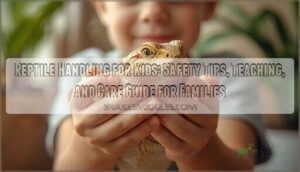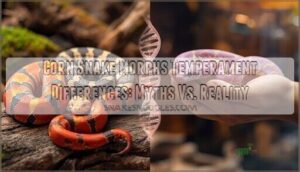This site is supported by our readers. We may earn a commission, at no cost to you, if you purchase through links.

Many parents worry their children aren’t ready for these scaly companions. The truth is that kids can become excellent reptile handlers when they learn the right skills. Understanding body language, mastering gentle support techniques, and practicing good hygiene transform nervous beginners into responsible caregivers who know exactly when to approach and when to give their pet space.
Table Of Contents
Key Takeaways
- Kids can become excellent reptile handlers when they learn to read body language, use gentle support techniques, and practice good hygiene under close adult supervision.
- Choosing the right species matters—docile reptiles like bearded dragons, corn snakes, and leopard geckos naturally fit family life and rarely show aggression during handling.
- Safe handling starts before you touch the reptile by setting up proper space, maintaining clean surfaces, and keeping adults within arm’s reach during every interaction.
- Recognizing stress signals like hissing, body inflation, and sudden movements helps kids know when to pause and give their pet space instead of pushing forward.
Choosing Kid-Friendly Reptile Species
Picking the right reptile for your child makes all the difference in safety and enjoyment. Each species has its own personality, care needs, and space requirements.
Here are some options for a family-friendly setup.
Recommended Reptiles for Children
Some reptiles just naturally fit in with families. Gentle Reptiles like corn snakes and ball pythons have earned their stripes as top Beginner Snakes—friendly, calm, and easy to care for.
Low-Maintenance Lizards, such as leopard geckos and bearded dragons, along with Docile Tortoises like the Russian tortoise, all make great Kid-Friendly Species for children. Selecting a reptile also depends on matching a child’s personality.
Temperament and Handling Ease
Finding the right fit goes beyond looks or color patterns—species docility and handling ease shape every interaction. Some, like bearded dragons or corn snakes, rarely show aggression and adjust well to gentle, regular handling. Others need slow habituation methods. Supervision isn’t optional; it keeps stress and accidents at bay so kids learn safely, one calm step at a time. Reptile owners should always consider children interaction to guarantee positive experiences.
- Docile species, such as ball pythons, often “ball up” rather than bite, making stress events safer for kids.
- Daily routines with brief, gentle sessions reduce handling stress and encourage habituation.
- Low aggression frequency means less risk—watch for territorial “show” rather than real threat.
- Behavioral predictors, like calmness during vet checks, signal easier handling for children.
- Build a safe learning environment by teaching kids to spot stress signals, always under close supervision.
Lifespan and Long-Term Commitment
Once you’ve found a gentle companion, pause and consider the full journey. Some reptiles, like corn snakes, become part of the family for 15 years or more, while tortoises may outlive your child’s childhood.
That’s real commitment duration—pet responsibility mixed with reptile care and ethical implications. Family planning around captive lifespans is just smart pet ownership and better child education.
Preparing for Safe Reptile Handling
Before your child picks up a reptile, it’s important to make sure everything is set up for safety. A good start means having the right space, supplies, and supervision.
Here’s what you’ll need to create a safe handling environment.
Setting Up a Safe Handling Area
Did you know a careless setup can undo even the best snake handling techniques? Keep child safety front and center with these essentials:
- Separate animal zones from kitchens or play areas—space separation is your best friend.
- Use hygienic, washable surfaces for easy surface disinfection.
- Control temperature and lighting for reptile comfort.
- Maintain strict supervision and access control for every handling session.
Essential Supplies and Equipment
No herpetologist skips the basics: Terrarium Essentials, Lighting Systems, and Handling Tools shape the bedrock of pet snake care and reptile safety. Add Cleaning Supplies and First-Aid Kits for total peace of mind. Equip kids with the right gear and you’ll make each handling session safer, cleaner, and easier. Here’s how the essentials stack up:
| Category | Example Tools | Purpose |
|---|---|---|
| Terrarium Essentials | Hygrometer, heat lamp | Maintain safe environment |
| Handling Tools | Snake hook, vinyl gloves | Support safe interaction |
| Cleaning Supplies | Chlorhexidine disinfectant | Guarantee hygiene and pet care |
Adult Supervision Guidelines
Because safety always comes first, constant vigilance is your best ally. Supervision means always staying within arm’s reach and guiding every child and animal interaction.
Hazard prevention starts before any snake handling begins—scan for risks, enforce proper hygiene, and keep emergency protocols ready.
Reptile safety hinges on strong training standards for adults, giving family reptile safety a solid foundation kids can trust.
Teaching Kids Reptile Body Language
Before your child can handle a reptile safely, it’s important they know how to read its body language. Not every twitch or movement means the same thing, and some behaviors signal it’s time to pause.
Here are a few signs to help kids recognize what a reptile is feeling.
Recognizing Signs of Stress or Aggression
Ever seen a snake hiss or a lizard puff up? Hissing signals stress, and body inflation isn’t just for show—it means “back off.” Watch for quick tongue flicking and sudden color changes, too. Aggressive tail whipping and sudden movement send a clear warning.
Helping your family read snake body language is key for safe, confident animal handling and family reptile safety.
Understanding Relaxed Vs. Defensive Postures
Imagine you’re reading a snake’s mood like a book. Relaxed indicators look like smooth, slow movements and gentle tongue flicks—almost like the snake is simply curious. Defensive signals are coiled, tense bodies. Shift signals show up as quick movements or color changes, and physiological signs include rapid breathing.
Context matters: snake handling gets easier when kids spot these subtle shifts in snake body language.
Warning Behaviors to Watch For
Kids need to spot warning signs before they become close calls. Sudden movements, defensive posturing, and aggressive behaviors are reptile red flags that shouldn’t be missed. Hissing or loud warning sounds are clear stress signals in snake body language. Watch for these:
- S-shaped neck coiling
- Body flattening
- Fast darting
- Hissing or clicking noises
Step-by-Step Reptile Handling Techniques
Getting hands-on with reptiles takes a gentle touch and the right steps.
Here’s how you can help your child handle their pet safely and confidently. Let’s walk through what to do from the very beginning.
Approaching and Picking Up Reptiles
Reptile handling starts with respect for the animal’s space; think of it like easing into a new friendship. Use a calm environment and move your hands slowly (about 10 cm/s) at a shallow approach angle. Quick grabs frighten snakes, so encourage kids to use gentle lifting. Controlled animal handling and safety depend on these early, simple handling techniques.
| Safety Precaution | Handling Tip |
|---|---|
| Calm Environment | Reduce loud sounds |
| Approach Angle | Reach from the side |
| Hand Speed | Move slowly ( Supervised reptile handling teaches children respect for living creatures, with studies showing 68% gain measurable responsibility through consistent care routines |
This family reptile safety approach transforms introducing snakes to children into lasting life lessons.
Educating Kids on Reptile Conservation
Teaching kids about reptile conservation turns pet ownership into something bigger. When children understand that their pet is part of a wild species that needs protection, they start to see themselves as caretakers of nature.
Here are the key conservation lessons you should share with your young reptile handler.
The Importance of Wildlife Protection
Wildlife conservation starts with understanding how every creature fits into the larger picture. You can explain to kids that biodiversity sustains ecosystem services we rely on—like clean water and pollination.
Wildlife education also helps children grasp how zoonotic diseases emerge when habitats shrink. Community innovations and conservation frameworks protect nature, while biodiversity finance funds these efforts.
Family education on reptile safety connects child education to protecting wild populations.
Ethical Reptile Ownership
Owning a reptile means more than feeding and cleaning. You’re committing to animal welfare and sustainable sourcing. Teach your kids that responsible pet ownership starts before you even bring a reptile home.
Three-quarters of the global reptile trade lacks sustainability verification, so choosing captive-bred animals protects wild populations. Legal frameworks exist to prevent harm, and following welfare standards ensures your family provides proper care throughout the reptile’s life.
Respecting Wild and Captive Reptiles
Teaching kids to respect reptiles means understanding the ripple effects of poor choices. Never release pet reptiles into the wild. Burmese pythons in Florida show how invasive species impact native wildlife and spread disease transmission risks.
Captive reptiles have emotional needs that deserve attention. When you handle reptiles with care and awareness, you’re practicing ethical reptile ownership and supporting real conservation implications for animal welfare.
Frequently Asked Questions (FAQs)
Can reptiles recognize their owners over time?
Research shows reptiles can recognize their owners through scent and behavior patterns. Snakes remember feeding routines and handling. They may respond differently to familiar versus unfamiliar handlers over time.
What temperature is safe for kids hands?
Kids’ hands can tolerate brief contact at temperatures below 43°C, where pain begins.
Safe handling means keeping reptile surface temps and enclosure heat under 30°C to prevent thermal injury risks and promote comfortable interaction.
How do reptiles behave during shedding periods?
During shedding periods, reptile behavior changes noticeably. Snakes become more reclusive and irritable. Sensory impairment like reduced vision makes them vulnerable.
Environmental needs shift too. Humidity around 70-80% prevents incomplete sheds.
Are reptiles good pets for apartment living?
Many reptiles thrive in apartments despite space constraints. Leopard geckos and crested geckos need only three to four square feet.
Noise levels stay low, and odor control is manageable with regular cleaning.
What sounds or noises stress reptiles out?
Loud machinery, traffic, and sudden sounds like fireworks trigger stress in reptiles. These creatures hear low-frequency vibrations well.
Urban noise impacts their behavior most, causing hiding and appetite loss through chronic stress indicators.
Conclusion
Some parents worry that reptile handling for kids means constant supervision and endless worry. The reality is different. When children learn proper techniques and body language reading skills, they develop independence alongside responsibility. Your role shifts from hovering protector to confident guide.
These lessons extend beyond the terrarium too. Kids who respect a bearded dragon’s boundaries often show greater empathy in other relationships. That’s the hidden gift of scaly companions.
- https://pmc.ncbi.nlm.nih.gov/articles/PMC3557882/
- https://www.cdc.gov/eis-conference/php/media-resources/reptile-associated-salmonellosis.html
- https://www.infectioncontroltoday.com/view/preschool-aged-children-high-risk-salmonella-reptiles
- https://safetyservices.ucdavis.edu/units/occupational-health/surveillance-system/zoonotic-diseases/reptiles
- https://www.hpsc.ie/a-z/zoonotic/reptilesandrisksofinfectiousdiseases/










